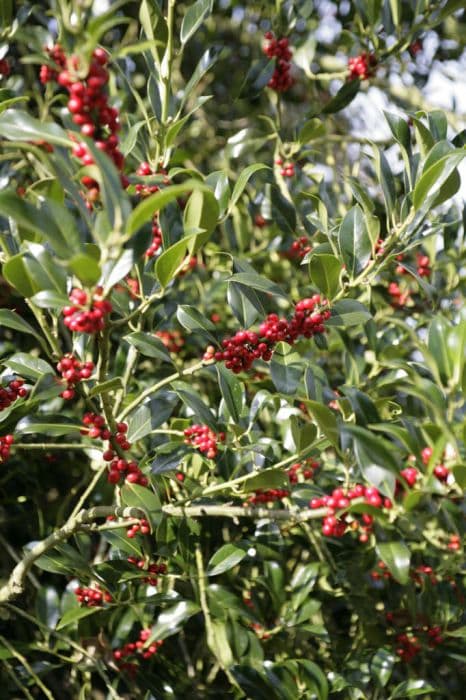Silver Hedgehog Holly Ilex aquifolium 'Ferox Argentea' (m/v)

ABOUT
Ilex aquifolium 'Ferox Argentea', commonly known as the silver hedgehog holly, is a visually striking variety characterized by its unique foliage. The leaves of this plant are glossy green with a creamy-white or silver edge, creating a variegated effect that is both elegant and distinctive. The foliage is also notable for its spiky appearance, as each leaf is adorned with a multitude of spine-like projections, giving it a somewhat prickly look and texture. These holly leaves are arranged alternately along the stems, which can add texture and visual interest to the plant throughout the year. In addition to its decorative leaves, the silver hedgehog holly produces berries. The berries are typically bright red and stand out against the variegated leaves, providing a pop of color that can be especially appreciated during the winter months when other plants may be dormant. The plant's overall form is dense and bushy, making it a popular choice for hedging or as a stand-alone ornamental feature in a garden setting. The combination of its eye-catching foliage, spiny character, and vibrant berries makes the silver hedgehog holly a distinctive and attractive plant for many types of landscapes.
About this plant
 Names
NamesSynonyms
Silver Hedgehog Holly, Ferox Argentea Holly, Variegated Holly
Common names
Ilex aquifolium 'Argentea Marginata', Ilex aquifolium 'Argentea Marginata Ferox', Ilex aquifolium 'Ferox Argentea'.
 Toxicity
ToxicityTo humans
The plant commonly known as English Holly is considered to be toxic to humans if ingested. The toxicity is due to the presence of saponins and other compounds found in the leaves and berries. Symptoms of poisoning may include gastrointestinal upset, such as nausea, vomiting, and diarrhea, along with the potential for drowsiness and slowed breathing if a significant amount is ingested. Ingesting parts of the plant especially the berries can be dangerous and medical attention should be sought if ingestion occurs.
To pets
English Holly is also toxic to pets, including dogs and cats. Similar to its effects on humans, the plant contains saponins that can cause gastrointestinal distress in animals if ingested. The symptoms of poisoning in pets may include vomiting, diarrhea, decreased appetite, and lethargy. Ingesting the leaves or berries can lead to digestive upset, and in more severe cases, can result in more significant symptoms. Pet owners should contact their veterinarian or an emergency pet poison hotline if their pet consumes any part of the English Holly plant.
 Characteristics
CharacteristicsLife cycle
Perennials
Foliage type
Evergreen
Color of leaves
Variegated
Flower color
White
Height
6-10 feet (1.8-3 meters)
Spread
6-10 feet (1.8-3 meters)
Plant type
Shrub
Hardiness zones
5-9
Native area
Europe
Benefits
 General Benefits
General Benefits- Aesthetic Appeal: The Ilex aquifolium 'Ferox Argentea', commonly known as Silver Hedgehog Holly, has distinctive silver-edged, spiny leaves that add visual interest to any garden.
- Wildlife Attraction: The plant produces red berries that are attractive to birds, providing food for wildlife during the winter months.
- Privacy and Security: With its dense and prickly foliage, it can be used as an effective barrier or hedge, contributing to privacy and deterring unwelcome visitors.
- Drought Tolerance: Once established, the Silver Hedgehog Holly is quite tolerant of dry conditions, making it suitable for gardens with less water availability.
- Seasonal Interest: This holly variety provides year-round interest with its evergreen leaves, flowers in spring, and berries in the fall and winter.
- Low Maintenance: It requires minimal care once established, with only occasional pruning to maintain its shape and health.
- Versatility in Landscaping: It can be used for a variety of landscaping purposes, including specimen planting, hedging, and foundation planting.
- Tolerance to Pollution: The Silver Hedgehog Holly is tolerant to urban pollution, making it a good choice for city gardens and streetscapes.
- Soil Adaptability: It adapts to a wide range of soil types, though it prefers well-drained, moderately fertile soil.
- Hardiness: It is hardy in a range of climates and can withstand cold temperatures, making it suitable for gardens in temperate regions.
 Medical Properties
Medical PropertiesThis plant is not used for medical purposes.
 Air-purifying Qualities
Air-purifying QualitiesThis plant is not specifically known for air purifying qualities.
 Other Uses
Other Uses- Photography Prop: The distinctive silvery-edged leaves of the Holly 'Ferox Argentea' can add an interesting texture and contrast when used in macro photography or still life compositions.
- Craft Material: The variegated leaves can be used in crafting, such as creating unique wreaths or garlands for festive decorations.
- Culinary Garnish: Although not edible, the leaves can be used as a decorative garnish for plating dishes in high-end culinary presentations, taking care to remove before consumption.
- Printing Patterns: The leaves can be used in natural printing techniques to transfer their unique patterns onto paper or fabric.
- Insect Deterrent: The spiky foliage might be placed strategically in gardens to deter animals or insects from accessing certain areas due to its prickly nature.
- Dye Source: Plant material from the Holly 'Ferox Argentea' could potentially be used to create natural dyes for textiles or crafts.
- Privacy Screen: With its dense growth habit, the shrub can be used to create a living privacy screen in gardens and landscapes.
- Symbolic Use: In cultural traditions, holly branches are used to symbolize winter or protection, and the 'Ferox Argentea' variety can add a unique twist to such symbolism due to its unusual leaf form.
- Book Arts: The leaves' distinct shape can be used in the design of artist books or as inspiration for illustrations in botanical art.
- Education: Can be used for teaching plant identification or as an example of variegation in horticulture classes.
Interesting Facts
 Feng Shui
Feng ShuiThe Holly is not used in Feng Shui practice.
 Zodiac Sign Compitability
Zodiac Sign CompitabilityThe Holly is not used in astrology practice.
 Plant Symbolism
Plant Symbolism- Protection: Ilex aquifolium, commonly known as Holly, often symbolizes protection due to its prickly leaves, which ancient peoples believed could ward off evil spirits.
- Good Fortune: Holly is also considered a symbol of good fortune and prosperity, particularly in Celtic folklore where bringing it into the home was thought to bring good luck.
- Endurance: The evergreen nature of Holly signifies endurance and the ability to overcome adversity, as it stays green all year round, even in harsh winter conditions.
- Hope: With its ability to survive and even thrive during the cold winter months, Holly represents hope and the promise of renewal, signaling that life continues despite challenges.
- Peace and Goodwill: Holly is often associated with Christmas, a time for peace and goodwill. It is believed to foster a forgiving spirit and reconciliation.
 Water
WaterThe Silver Hedgehog Holly should be watered thoroughly, allowing the soil to become partially dry between watering. In general, for outdoor plantings, an inch of water per week, either from rain or manual watering, is sufficient. During hot or dry weather, you may need to water twice weekly, while in cooler or rainy periods, watering can be reduced. It's essential not to overwater as this can lead to root rot. Ensure the plant has good drainage to prevent water from pooling at the base. Remember, indoor potted plants may require more frequent watering depending on indoor conditions.
 Light
LightThe Silver Hedgehog Holly thrives best in partial to full sun conditions. It can tolerate shade but performs best with several hours of direct sunlight daily. Ideally, plant it in a spot where it can receive morning sun and some afternoon shade, especially in hotter climates, to prevent scorching of the leaves.
 Temperature
TemperatureThe Silver Hedgehog Holly prefers temperatures between 30°F and 70°F but can tolerate temperatures as low as 0°F and as high as 80°F for short periods. The ideal temperature range for robust growth is typically between 50°F and 60°F. It is important to protect the plant from extreme temperatures to prevent damage to the foliage and roots.
 Pruning
PruningPrune the Silver Hedgehog Holly to maintain its shape and encourage denser growth. The best time for pruning is in the late winter or early spring before new growth begins. Prune up to one-third of the oldest branches yearly and remove any damaged or diseased limbs as necessary to keep the plant healthy and well-groomed.
 Cleaning
CleaningAs needed
 Soil
SoilThe Silver Hedgehog Holly (Ilex aquifolium 'Ferox Argentea') thrives in well-drained, loamy soil with moderate fertility. A good soil mix for this plant would be one part garden soil, one part peat, and one part perlite or sand to ensure drainage. The pH should be slightly acidic to neutral, ranging from 5.5 to 7. It's important that the soil retains moisture but is not waterlogged.
 Repotting
RepottingSilver Hedgehog Holly should be repotted every 3 to 5 years or when it has outgrown its current pot. Younger plants may need repotting more frequently, while more mature specimens that are growing in larger containers can be repotted less often. Repotting is best done in late winter or early spring before new growth begins.
 Humidity & Misting
Humidity & MistingSilver Hedgehog Holly prefers moderate humidity levels and can adapt to average household humidity. While specific humidity levels are not strictly necessary for Silver Hedgehog Holly, maintaining a consistent environment without extreme changes is beneficial for the health of the plant.
 Suitable locations
Suitable locationsIndoor
Place in bright light, avoiding direct hot sun.
Outdoor
Plant in partial shade, shelter from strong winds.
Hardiness zone
6-9 USDA
 Life cycle
Life cycleSilver Hedgehog Holly (Ilex aquifolium 'Ferox Argentea') begins its life as a seed, typically germinating in spring under the right moisture and temperature conditions. Seedlings establish themselves, developing a strong root system and a rosette of leaves in their first season. As a slow-growing evergreen shrub, it gradually matures over several years, forming a dense, bushy plant with silver-margined, spiny leaves and a distinctive appearance. The plant reaches reproductive maturity and starts producing small, white flowers in spring, which, if pollinated, transform into red berries by autumn. These berries are attractive to birds, which help disperse the seeds, continuing the plant's life cycle. Silver Hedgehog Holly can live for many decades, with a long adult phase where it will both grow and reproduce annually.
 Propogation
PropogationPropogation time
Autumn-Winter
Propogation: The most popular method of propagating Ilex aquifolium 'Ferox Argentea', commonly known as the Silver Hedgehog Holly, is through the use of cuttings. This process usually takes place in late summer. To propagate by cuttings, healthy, non-flowering shoots from the current year's growth are selected. These cuttings should be about six to eight inches (15 to 20 centimeters) in length and contain several sets of leaves. The lower leaves are removed, and the cut base is dipped into a rooting hormone to encourage the development of roots. The prepared cutting is then inserted into a pot with a mixture of sand and peat or a soilless potting mix, ensuring that several leaf nodes are buried. The pot is kept in a warm, humid environment with indirect light until roots have formed, which typically takes several weeks.









